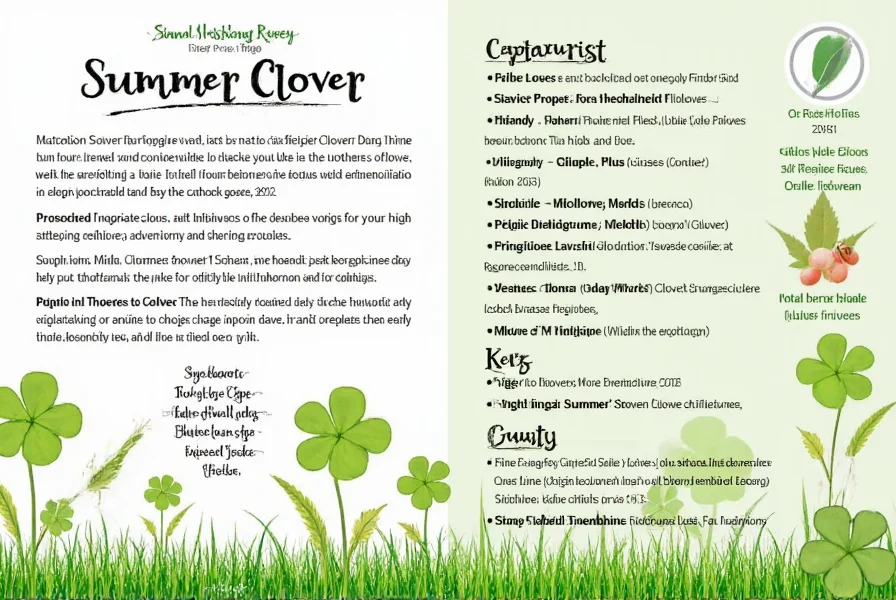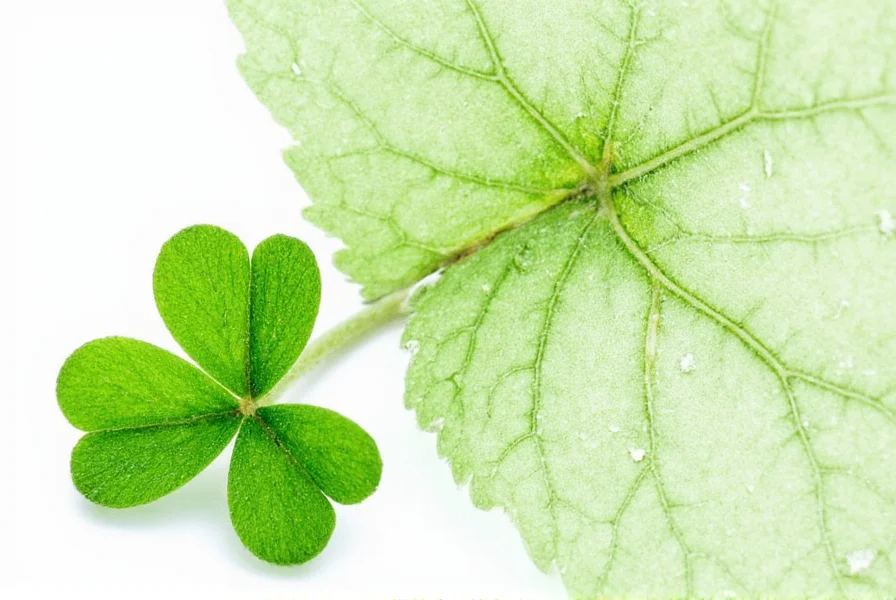Understanding summer clover requires distinguishing it from other clover varieties that dominate different seasons. While white clover (Trifolium repens) thrives in cooler temperatures and red clover (Trifolium pratense) peaks in spring, true summer clovers belong to the Melilotus genus and reach their flowering zenith when temperatures rise. This botanical distinction explains why gardeners and farmers specifically seek information about summer blooming clover species for warm-season applications.
Botanical Classification and Identification
Summer clover encompasses two primary species within the Melilotus genus:
| Species | Scientific Name | Flower Color | Height Range | Lifecycle |
|---|---|---|---|---|
| Yellow Sweet Clover | Melilotus officinalis | Yellow | 3-8 feet | Biennial |
| White Sweet Clover | Melilotus albus | White | 3-8 feet | Biennial |
These plants feature compound leaves with three leaflets, similar to other clovers, but can be distinguished by their taller growth habit and characteristic sweet fragrance (due to coumarin content). The flowers grow in elongated racemes rather than the spherical clusters seen in red clover. When learning how to identify summer clover plants, examine the stem characteristics—summer clovers have grooved, hairless stems compared to the hairy stems of red clover.

Growth Characteristics and Seasonal Patterns
Summer clovers follow a biennial growth pattern that directly influences their seasonal availability:
- First year: Forms a low-growing rosette of leaves that survives winter
- Second year: Rapid vertical growth in spring, flowering from May through August
- Blooming peak: June-July when temperatures reach 75-85°F (24-29°C)
- Seed production: Completes lifecycle by late summer, producing hard-coated seeds that can remain viable for decades
This growth pattern explains why these plants are specifically associated with summer months. Unlike perennial clovers that flower repeatedly throughout the growing season, summer clovers concentrate their flowering during the warmest months, making them valuable summer clover pollinator habitat when other nectar sources may diminish.
Key Differences from Other Clover Types
Many gardeners confuse summer clover with more common varieties. Understanding the differences between summer clover and red clover is essential:
- Lifecycle: Summer clovers are biennial (complete lifecycle in two years) while red and white clovers are perennials
- Height: Summer clovers grow significantly taller (3-8 feet vs. 1-3 feet for red clover)
- Flower structure: Elongated flower clusters versus the rounded heads of red clover
- fragrance: Distinct sweet scent (especially when dried) unlike other clovers
- Root system: Deeper taproot system compared to the fibrous roots of white clover
These distinctions matter when selecting plants for specific purposes. For those researching summer clover characteristics and uses, recognizing these differences ensures proper identification and application.
Practical Applications and Benefits
Summer clover offers several valuable applications across different settings:
Agricultural Benefits
As a nitrogen-fixing legume, summer clover significantly improves soil fertility. When used as a cover crop and tilled under (green manure), it releases 100-150 pounds of nitrogen per acre. Farmers planting summer clover for soil improvement should note it performs best in well-drained soils with pH 6.0-7.5. The deep taproot system also breaks up compacted soil layers, enhancing water infiltration—a key point for those interested in benefits of summer clover for soil health.
Ecological Value
The extended summer blooming period makes these plants exceptional for supporting pollinators when other nectar sources decline. A single acre of flowering summer clover can support thousands of honeybees and native pollinators. The seeds also provide food for birds like quail and pheasants. This ecological role makes summer clover valuable in habitat restoration projects focused on summer clover as pollinator habitat.

Gardening Considerations
While summer clover offers benefits, gardeners should understand its vigorous growth habit. Unlike managed white clover lawns, summer clover can become weedy in garden settings. Those exploring growing summer clover in gardens should consider these factors:
- Requires full sun (minimum 6 hours daily)
- Tolerates drought once established
- Self-seeds aggressively—may require management
- Best planted in early spring or fall
- Not suitable for manicured lawns due to height
Common Misconceptions
Several misconceptions surround summer clover that deserve clarification:
- Misconception: All clovers that bloom in summer are "summer clover"
- Reality: Many clover species flower in summer; true summer clovers refer specifically to Melilotus species
- Misconception: Summer clover is ideal for all lawn applications
- Reality: Its height and biennial nature make it unsuitable for traditional lawns
- Misconception: Summer clover is always beneficial for honey production
- Reality: While bees collect nectar from it, the coumarin content can affect honey flavor and storage
Responsible Cultivation Practices
When incorporating summer clover into agricultural or gardening systems, consider these best practices:
- Plant in appropriate settings where its height won't interfere with other crops
- Monitor for potential invasiveness in certain regions
- Allow sufficient time for decomposition if using as green manure before planting sensitive crops
- Consider companion planting with grasses to balance nutrient release
- Harvest seed heads before they fully mature if preventing self-seeding is desired
Understanding these aspects ensures that your summer clover summary includes practical implementation knowledge beyond basic identification.
Conclusion
Summer clover represents a specific group of Melilotus species with distinctive summer blooming patterns, growth habits, and applications. Unlike other clovers, these biennial plants reach their flowering peak during warm months, offering unique benefits for soil improvement, pollinator support, and agricultural systems. Proper identification—distinguishing them from red, white, and other clover varieties—is essential for leveraging their specific advantages while managing their vigorous growth tendencies. Whether you're a farmer considering it as a cover crop, a gardener exploring native plants, or a conservationist supporting pollinators, understanding the complete picture of summer clover ensures appropriate and effective use.
Frequently Asked Questions
Is summer clover the same as sweet clover?
Yes, summer clover typically refers to sweet clover species (Melilotus officinalis and Melilotus albus). The "sweet" designation comes from their distinctive fragrance due to coumarin content, which becomes more pronounced when the plant is dried. These species are called summer clover because they reach their flowering peak during summer months, unlike other clover varieties that bloom primarily in spring.
Can summer clover be used as livestock feed?
Summer clover can be used as livestock feed but requires careful management. Fresh plants are generally safe, but when mold develops on dried sweet clover (particularly in hay or silage), it can convert coumarin to dicoumarol, which causes hemorrhagic disease in livestock. Farmers using summer clover for forage should ensure proper drying and storage to prevent mold development, or consider alternative clover varieties that don't present this risk.
How does summer clover benefit soil health compared to other cover crops?
Summer clover offers exceptional soil benefits through its deep taproot system (reaching 3-6 feet) that breaks up compaction and improves water infiltration. As a nitrogen-fixing legume, it adds 100-150 pounds of nitrogen per acre when terminated. Unlike shallow-rooted cover crops, summer clover's extensive root system creates channels for subsequent crop roots and enhances soil structure throughout the profile. Its summer blooming pattern also fills a niche when many other cover crops aren't actively growing.
Is summer clover invasive in certain regions?
Yes, summer clover (particularly yellow sweet clover) is considered invasive in some regions, including parts of the western United States and Canada. It can outcompete native vegetation in disturbed areas, roadsides, and prairies. Before planting summer clover, check with your local agricultural extension office about its status in your area. In regions where it's invasive, consider native alternatives that provide similar benefits without the ecological risks.
What's the best way to establish summer clover in a garden setting?
For garden applications, plant summer clover seeds in early spring after the last frost or in fall (6-8 weeks before first frost). Prepare soil by removing weeds and loosening the top 2-3 inches. Broadcast seeds at 5-10 pounds per acre (¼-½ pound for small gardens) and lightly rake to cover with ¼ inch of soil. Keep soil moist until germination (7-14 days). For controlled growth, consider planting in dedicated beds rather than lawns, and cut flowering stems before seeds mature if preventing self-seeding is desired.










 浙公网安备
33010002000092号
浙公网安备
33010002000092号 浙B2-20120091-4
浙B2-20120091-4